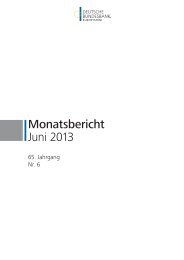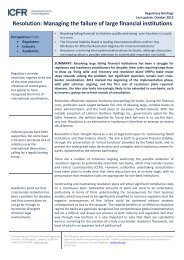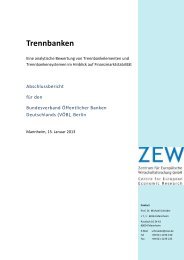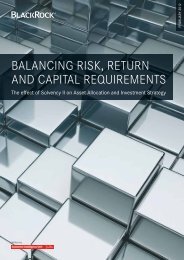A Proposal for the Resolution of Systemically Important Assets and ...
A Proposal for the Resolution of Systemically Important Assets and ...
A Proposal for the Resolution of Systemically Important Assets and ...
Create successful ePaper yourself
Turn your PDF publications into a flip-book with our unique Google optimized e-Paper software.
Havinghighlighted<strong>the</strong>variousbenefits<strong>of</strong>ourproposedapproachsuchasitsflexibilityin<br />
extending to new asset <strong>and</strong> liability classes over time <strong>and</strong> <strong>the</strong> difficulty <strong>of</strong> gaming it by <strong>the</strong><br />
financialsectorsinceitoperates<strong>for</strong>allinstitutionsparticipatinginagivenassetorliabilityclass,<br />
wenotethatitdoes–like<strong>the</strong>DoddFrankAct<strong>and</strong><strong>the</strong>OLA–relyonacertainamount<strong>of</strong>ability<br />
<strong>of</strong><strong>the</strong>regulatorstogetthingsright.Inparticular,<strong>the</strong>approachreliesonregulatorstobeable<br />
toestimateconservativevalues<strong>of</strong>collateralwhichnecessitates(perhapsincentivizes)<strong>the</strong>mto<br />
ensure sufficient transparency <strong>of</strong> prices in underlying asset markets in normal times. The<br />
approachalsoreliesonadequateincentives<strong>for</strong><strong>the</strong>resolutionauthoritytoadoptexanterisk<br />
controls in <strong>the</strong> <strong>for</strong>m <strong>of</strong>haircuts, concentrationlimits, <strong>and</strong>eligibility restrictions on collateral,<br />
among o<strong>the</strong>rs. While <strong>the</strong> approach can be harmonized internationally in a relatively<br />
straight<strong>for</strong>wardmannerifsuchcontrolsareharmonized,competition<strong>for</strong>marketsharesacross<br />
borders can potentially put downward pressure on <strong>the</strong> adoption <strong>and</strong> <strong>the</strong> extent <strong>of</strong> <strong>the</strong>se<br />
controls in practice. For this reason, besides <strong>the</strong> fact that <strong>the</strong> lenders <strong>of</strong> last resort such as<br />
centralbankswouldultimatelyhavetostepinwhen<strong>the</strong>seauthoritiesdonothaveadequate<br />
liquidity to make conservative payments, <strong>the</strong> lenders <strong>of</strong> last resort would need to act as<br />
watchdogsoverourproposedresolutionauthorities,preventingaraceto<strong>the</strong>bottomin<strong>the</strong>ir<br />
riskcontrols.<br />
<br />
V.AHistoricalPrecedent:TheGlass<strong>Proposal</strong><br />
As Graeber (2011), <strong>and</strong> Reinhart <strong>and</strong> Rog<strong>of</strong>f (2009) documented, banking crises have<br />
beenubiquitousthroughoutrecenthistory<strong>and</strong>onecommonproblemtoalmostallhasbeen<br />
<strong>the</strong>loss<strong>of</strong>liquiditytobankdepositors.In<strong>the</strong>wake<strong>of</strong>one<strong>of</strong><strong>the</strong>secrises,namely,<strong>the</strong>banking<br />
panic<strong>of</strong>1907,<strong>the</strong>NationalMonetaryCommission<strong>of</strong><strong>the</strong>U.S.establishedby<strong>the</strong>Congressin<br />
<strong>the</strong>AldrichVreel<strong>and</strong>Act<strong>of</strong>1908–prepareda19questionquestionnaire<strong>and</strong>mailedtovarious<br />
representatives<strong>of</strong><strong>the</strong>U.S.bankingindustry(Kaufman,2004).One<strong>of</strong><strong>the</strong>questions–<strong>the</strong>18 th –<br />
asked: 30 <br />
<br />
“Woulditbewell,inyouropinion,tochange<strong>the</strong>existinglawssothatliquidatingbanks<br />
could,insomeway,arrangetopaydepositorsmorerapidly?Acarefulexamination<strong>of</strong><br />
<strong>the</strong>assets<strong>of</strong>failedbankswillshowabouthowmuchdividend<strong>the</strong>ycaneventuallypay,<br />
<strong>and</strong>considerabledistresswouldbepreventedifsomethingapproximatingthisamount<br />
couldbepaidtodepositorswithoutanydelay.”<br />
AsKaufman(2004)reports,“(r)esponseswereobtainedfrom85respondents.Of<strong>the</strong>se,63,or<br />
sometwothirds,favoredachangetopaydepositors<strong>of</strong>closedbanksmorerapidly.Thispercent<br />
was<strong>the</strong>sameamongbankers<strong>and</strong>bankexaminers,<strong>the</strong>twolargestgroups<strong>of</strong>respondents.Only<br />
12respondents,or14%wereopposedtosuchachange<strong>and</strong><strong>the</strong>remainderei<strong>the</strong>rskipped<strong>the</strong><br />
questionorwereundecided.”<br />
Aswementionedin<strong>the</strong>opening<strong>of</strong>SectionII,acentralobjective<strong>of</strong><strong>the</strong>DFAistocreate<br />
a new resolution mechanism <strong>for</strong> nonbank SIFIs <strong>and</strong> bring <strong>the</strong>m within <strong>the</strong> FDIC insurance<br />
<br />
30 AsquotedbyKaufman(2004),p.243<br />
31




